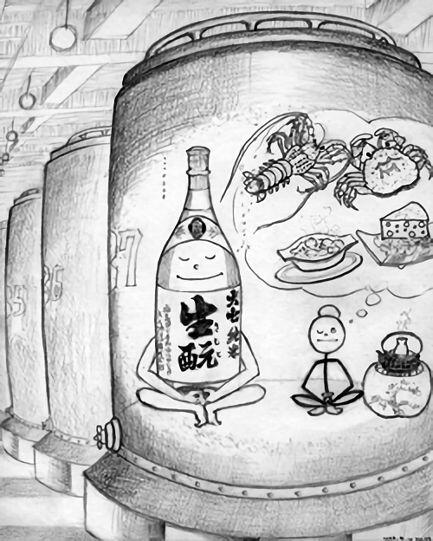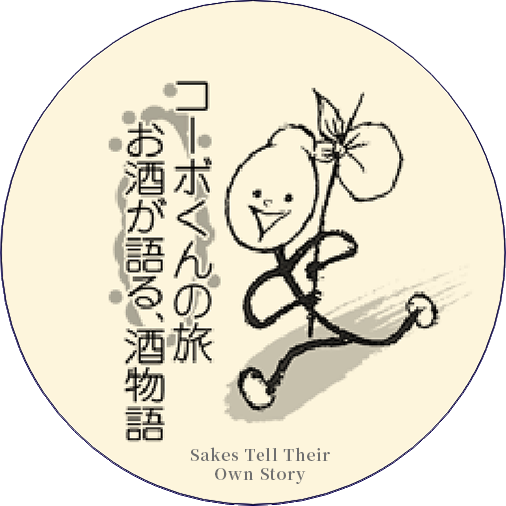Junmai Kimoto Yamada Nishiki
| Yeast | “Today I’m going to visit Junmai Kimoto Yamada Nishiki. Although he came later to market, he is in fact the older brother of Junmai Kimoto.” |
|---|---|
 |
|
| Yamada Nishiki | “Hello Yeast, please come in.” |
| Yeast | “Thanks. ‘Yamada Nishiki’ in your name refers to a rice brand, doesn’t it?” |
| Yamada Nishiki | “Yes, Yamada Nishiki is the longtime king of all sake rice brands. With its large grains it’s very suitable to sake brewing, but it takes a lot of effort to grow and the production volume therefore is low.” |
| Yeast | “I see. Is that the reason why the precious Yamada Nishiki rice has so far been only used for ginjo and daiginjo sakes?” |
| Yamada Nishiki | “Yes, it’s an original idea of Daishichi to use Yamada Nishiki for a junmai sake like myself. The point is that Daishichi does not consider junmai sake as lower in grade than junmai ginjo sake. Daishichi sees junmai sake rather as sake with a different sort of taste.” |
| Yeast | “What sort of taste is that?” |
| Yamada Nishiki | “The taste that junmai sake aims for is quite different from the delicate and fruity taste of junmai ginjo sake. I aim at a more rich and well-defined umami, a delicious taste that comes out even better when I’m served warm. It takes a lot of effort to achieve that.” |
| Yeast | “I see, polishing the rice as far as possible is not the only way that leads to high-grade sake!” |
| Yamada Nishiki | “Precisely, it only drives up the cost of the ingredient, the rice. As regards rice polishing, it’s more important to polish the grains one by one evenly and in equal thickness from the surface.” |
| Yeast | “There it is: the flat rice polishing technique!” |
| Yamada Nishiki | “And the rice then has to be steamed for a long time with dry steam.” |
| Yeast | “I see, that must be why Daishichi prefers traditional Japanese cast iron cauldrons, and recently even had new ones cast.” |
| Yamada Nishiki | “Precisely! There are still many things I would like to talk about, such as koji making and the kimoto method, but do you know what is most important?” |
| Yeast | “Most important…?” |
| Yamada Nishiki | “To take plenty of time for maturation. There exists a delicious taste which can only be granted by time. The short-lived sake made with the simplified method of cultivating the starting mash (sokujomoto) is not suitable for maturation. Only choice sake, which is predisposed to it, is able to reap the benefits of time. That’s exactly where the potential of the kimoto method comes fully into play.” |
| Yeast | “You’ve been matured in a storeroom with a perfect environment for many years. That’s why you are more expensive than ginjo sakes.” |
| Yamada Nishiki | “Yes, the long time I need before I am ready for drinking, is my greatest extravagance. A product like me can only exist because there are fans who understand its value.” |
| Yeast | “You are the essence of Daishichi’s philosophy, Yamada Nishiki! What dishes do you fit to?” |
| Yamada Nishiki | “I have a superior aftertaste and to that fits steamed white fish with just a touch of sudachi citrus. Also sashimi of prawn and crab, as well as hot pot of fish and vegetables. And as kimoto sake contains the creaminess of lactic acid, I also fit to gratin and cheese.” |
| Yeast | “I always wrongly thought that cheese only fitted to wine… And what is your serving suggestion?” |
| Yamada Nishiki | “To enjoy my deep taste to the full, it’s best to drink me at room temperature. But I’m even more delicious when I have been slightly warmed to 40-45 ºC.” |
| Yeast | “Indeed, you’ve won the platinum prize in the category of ‘Sake that is Delicious When Warmed’ at the Great Jizake Show! After all, warm sake is the most delicious! Thank you very much!” |
A




